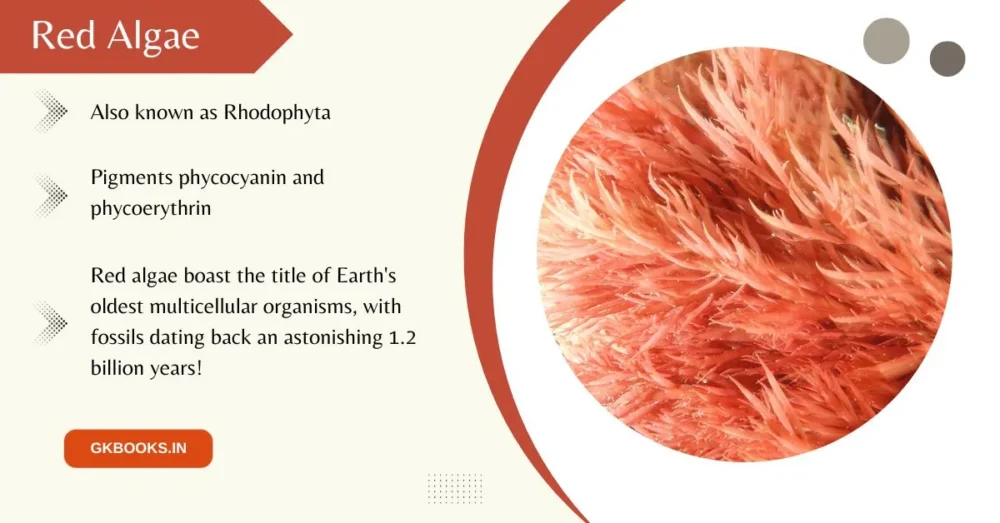Rhodophyceae, commonly known as red algae, is a group of algae that mainly live in marine environments. They are unique due to the predominance of the red pigment, R-phycoerythrin, in their body. These algae play a significant role in marine ecosystems and have various uses in food, industry, and medicine.
What is Rhodophyceae?
- Rhodophyceae is a class of algae under the division Rhodophyta, commonly known as red algae.
- These algae are mainly found in marine environments, especially in deep waters where light penetration is low.
- They are photosynthetic and contain phycobiliproteins (phycoerythrin and phycocyanin), which give them their characteristic red color.
Characteristics of Rhodophyceae
1. Habitat
- Mostly found in marine environments, especially in warm tropical waters.
- Some species also grow in freshwater and terrestrial environments.
- They occur in both well-lighted regions close to the surface of water and at great depths in oceans, where relatively little light penetrates.
2. Color and Pigments
- The red color is due to the presence of phycoerythrin, which absorbs blue and green light, allowing them to grow at greater ocean depths.
- Other pigments include chlorophyll a, chlorophyll d, and Phycocyanin.

3. Cell Structure
- The cells are eukaryotic (having a true nucleus).
- They have cell walls made of cellulose and mucilage, often with calcium carbonate deposits in some species.
- No flagella (tiny whip-like structures used for movement in other algae groups).
- The red thalli of most red algae are multicellular, and some have complex body organization.
4. Reserve Food
- The stored food in Rhodophyceae is floridean starch, which is very similar to amylopectin and glycogen in structure.
5. Reproduction
- Vegetative Reproduction: Occurs by fragmentation.
- Asexual Reproduction: Occurs through non-motile spores such as monospores, aplanospores, and tetraspores.
- Sexual Reproduction: Oogamous, meaning it involves a large, non-motile egg and a small, non-motile male gamete.
- Complex Post-Fertilization Development: The reproductive cycle includes haploid gametophyte and diploid sporophyte stages.
Examples of Rhodophyceae
| Scientific Name | Common Name | Uses |
|---|---|---|
| Gelidium | Agar-producing algae | Used in making agar (used in microbiology and food industry) |
| Gracilaria | Red algae | Used in agar and food products |
| Porphyra | Nori | Used in sushi wrapping |
| Polysiphonia | Marine algae | Found in marine environments |
| Corallina | Coral-like algae | Helps in coral reef formation |
Importance of Rhodophyceae
1. Ecological Importance
- Provides food and habitat for marine organisms.
- Helps in coral reef formation by depositing calcium carbonate.
2. Economic Importance
- Agar Production: Agar is extracted from Gelidium and Gracilaria and is used in microbiology labs and food industries.
- Carrageenan Extraction: Used in food processing as a thickener and stabilizer.
- Edible Algae: Porphyra (nori) is widely consumed, especially in Japan.
- Medicine: Some red algae have antiviral and antibacterial properties.
Interesting Facts about Red Algae
- Red algae are among the oldest eukaryotic organisms, dating back more than 1.2 billion years.
- They can survive in extreme environments, including deep ocean waters where little sunlight reaches.
- Some red algae species contribute to limestone (coral reef) formation.
Fun Facts About Rhodophyceae
- Red algae can live at greater depths than green and brown algae due to their special pigments.
- Some species of red algae are used in making ice cream and toothpaste!
- Coralline red algae play a role in strengthening coral reefs.
Quick Revision Points:
✅ Red color due to r-phycoerythrin
✅ Mostly marine, with some freshwater species
✅ Found in well-lit and deep-sea environments
✅ Used for agar, carrageenan, and food products
✅ Lack flagella and store food as floridean starch
✅ Help in coral reef formation
Conclusion
Rhodophyceae, or red algae, is an essential group of algae with unique characteristics and multiple benefits. They contribute significantly to marine ecosystems and have important applications in food, industry, and medicine. Understanding their properties can help in competitive exams like SSC, RRB NTPC, UPSC, and state-level exams. Keep learning, and stay curious about the fascinating world of algae!
Did you find this post helpful? Keep exploring more about biology and science to boost your exam preparation! 🚀







